| Cottonwood
to celebrate 150th year in 2012, area history included
(History continued from last week) Because of all the transition history-going from WWI through the bumpy years in the 1920s, the depression in the 1930s and then back to the anxious years before WWII-we need to recall those who went through all the bumps and grinds and upheld the ways and means of our tradition. This then was the time when some of the farm and ranch families bought or rented a house in town so that their children could get on to High School. Also some of the kids from the outlaying areas boarded in town during the school year. As you can see in the 1929 picture in the previous week’s paper, some of the families were from Winona, West Lake and Joseph Plains. This was also true of Ferdinand and Greencreek High Schools. A number of you remember the telephone with the ringer crank and operator’s answer “number please.” How about the rubber necks? There usually was a comfortable chair setting under the phone for those “long winded” calls. At a birthday party the other day, some of the older people got to talking history-one of the subjects that came up was the camping trips in the 30’s and 40’s. No it wasn’t just for fishing or hunting, it was a “reasonable” form of family entertainment too. Sometimes 4 or 5 older people would stay up on the mountain for a week while picking huckleberries. Some referred to this as “milking mice.” All 5 generations of our family talk of the family camping trips at Red River, Selway and Gospel Mountains. The little kids especially remember swimming in the cold lakes and streams, sleeping in a lean-to or canvas tent, the lanterns in the evening, cooking on the fire, etc. In spite of the crawling out of the depression and the probability of WWII, the livestock market was established and soon became a dominant factor here in central Idaho. Farm prices were off by close to 50% and then started to come back in the late 30’s. New combines started to come on the scene to replace the threshers as well as binders and mowing machines. Some of the new pull-type combines had 16 ft. headers! Some of the older trucks were loaded to the hilt-15 ft. beds and 20’ high racks. When there was a field fire, everyone responded, farmers and merchants alike, and most fires were quickly suppressed. In the mid-1930’s the insurance companies started to hustle the farm loan business, offering low interest 2nd position loans. In some cases these were the downfall of quite a few borrowers. Some of these low interests loans for under $400.00 put people out of business and their farms sold by the loan sharks at quick profit for a song. The old land exchange records show some out of the area insurance companies taking over quite a few farms in the 1930’s. Seems like the closer we got to war, the better prices were and also like usual, more men went to work. This was also the start of both men and women working out of the same family for hire. Everyone in the family worked in and around home. If you didn’t look busy, Dad or Mom would put you on doing house or farm chores. One of the least attractive jobs was cleaning out the chicken coop! Usually Sunday was chicken dinner, so on Saturday you got to chop off the heads and pick the feathers. Sometimes Dad would load us all into the truck or pickup for a family picnic down on the Salmon River or up the South Fork. A day away from the usual things and just plain having fun in the “ole swimming hole.” We would all be looking forward to one of these trips and low and behold, it was raining! We would usually throw in a tarp and go anyway as in the country the storms would leave as fast as they came. Even the lady of the house liked to get in a change in routine on the special days. Memories, memories. How lucky we were to have all these creeks, rivers and country just out the back door! In the spring, summer and early fall the time to play was limited by the work left to be done. It was not common to always wear shoes and like other items of clothing, in most families, hand-me-downs were the order of the day. Most families had access to a sewing awl, used for horses, and they were mighty handy for sewing up soles of shoes too! As times, money and conditions changed, so did our local and federal government. Some programs were dropped due to improved money conditions but then some new ones were added. Here, some people still carried their water to the house or cabin by bucket. A lot of people used the privy out back. There were a number of families that had limited use or they still had no electricity. What things like this would make such a big change in their everyday life when the REA finally got around to them! Just think of all the people who milked up to ten or twelve cows by hand. Stay in there they did, in a few years the milking machines would appear on the scene. 10 years from now would make quite a difference in most things in our lives. The coming of war would put us through a time of “doing without” but, the new items being developed would be many, and it was hard to admit the good that would come from these times. 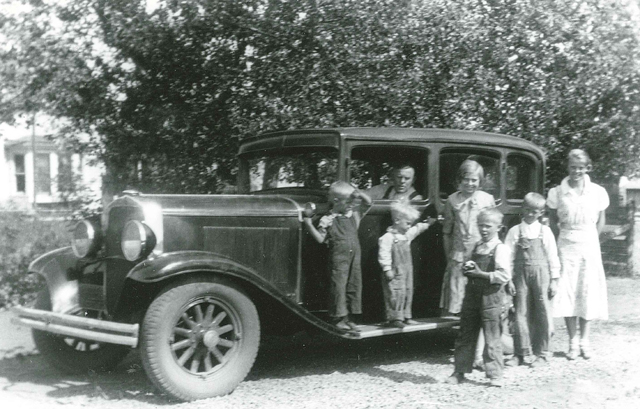
Frank Arnzen in his Desoto. From left are Maynard, Urban, Florence, Alvin, Francis and Regina. 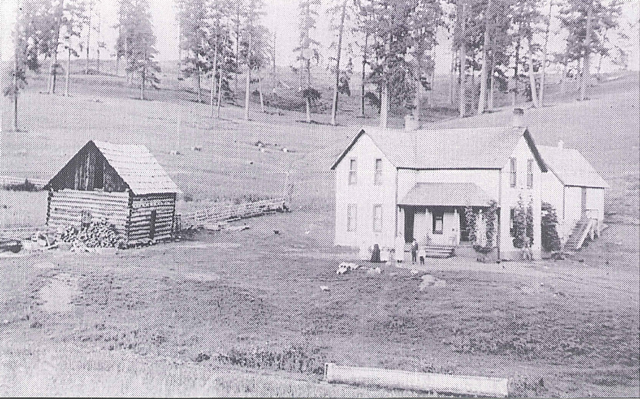
The Frank Enneking homestead on Deep Creek. At left is the first cabin they stayed in and at right the first house they built. Photo provided by Mrs. Ed Uptmor. 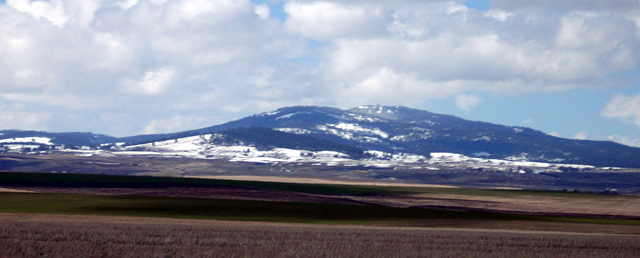
Cottonwood Butte, which has been watching over us for the past 150 years doesn’t look a whole lot different than it did to the first settlers. It raises about 2,000 feet over the Prairie. Photo by Don Hoene. 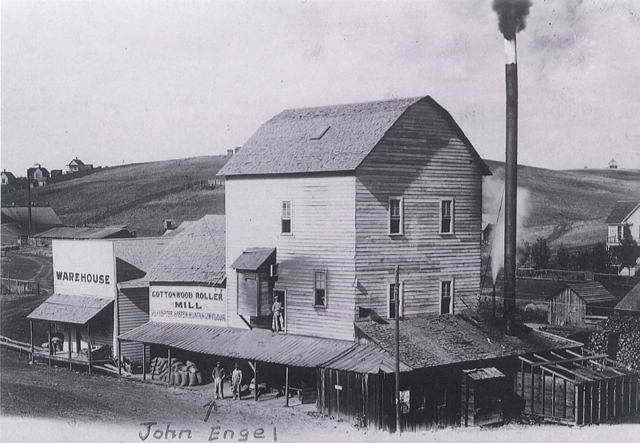
The Cottonwood Roller Mill in the early 1900’s. This was located where the Long’s Auto Sales site is now. John Engel, pointed out in the photo, was a steam engineer. Photo provided by Mrs. Ed Uptmor. 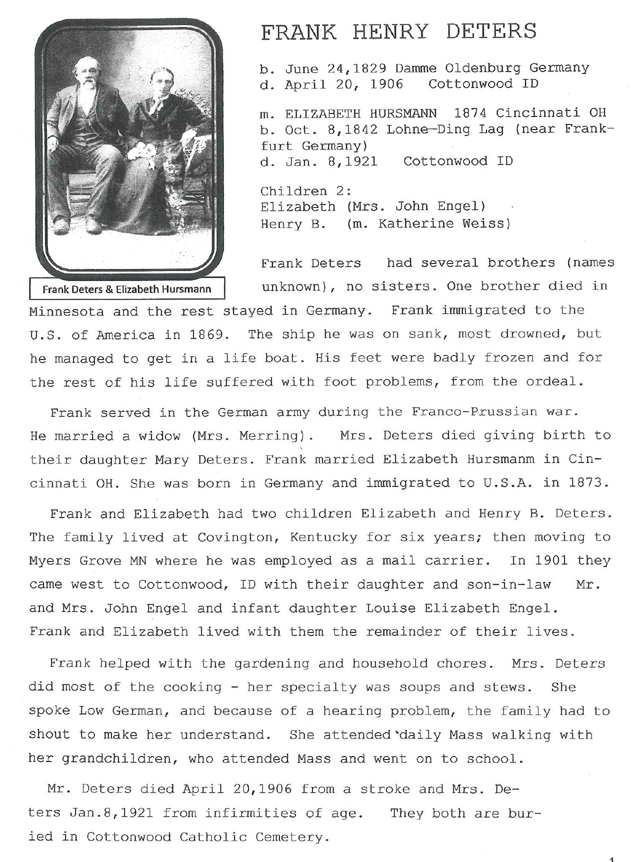
Shown above is a sample page layout for the proposed family history book which will be printed on 8 1/2x11 size pages. Remember When Remember When… The songs we danced to and spent many hours singing were filled with feeling and emotion? “You Are My Sunshine,” “Darling Clementine,” “Springtime in the Rockies,” “Red River Valley,” “After the Ball was Over,” “Blue Eyes Crying in the Rain,” “Don’t Sit Under the Apple Tree,” and one more “Let Me Call You Sweetheart.” The whole world had problems and these happy moments seemed to put a band-aid on them! Almost all gatherings of all kinds seemed to open and close with music. Remember when Joe Stubbers played the piano? Anything you wanted-by ear? The home made toys and dolls-Raggedy Ann? As we got closer and closer to war, the gatherings around the radio? The homemade doll houses? The wood wagons and trucks? Every old metal wheel of any kind improved a new tractor or truck? You heard of several middle age mothers with three to ten children going on 20 mile horseback rides in what is now the Frank Church Wilderness, not only once but several times in as many years? Check with Jane Hoene, Peggy Uhlorn, Edna Ruhoff, Irma Tacke and be sure to include Sally Terhaar! “Whoa, you. S.O.B., whoa!” Then on some of the bigger trips came the question, “Who’s on oats?” The next meeting of the 150-Year History Committee will be Thursday, December 1st, at 2 p.m. in the Library. 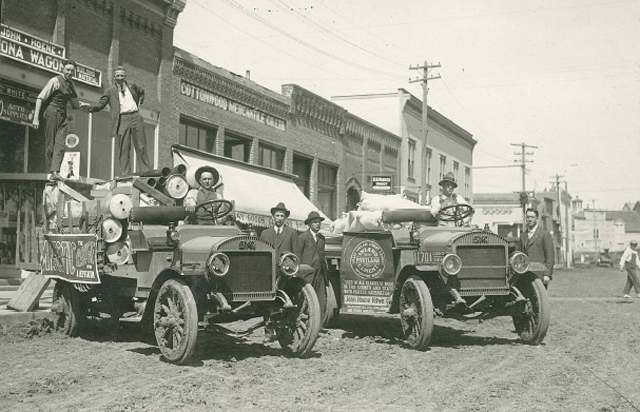
A couple of vintage GMC trucks unloading merchandise at Hoene Hardware on Main Street. The one on the right says Portland Cement. Photo courtesy of Claudia Gehring. 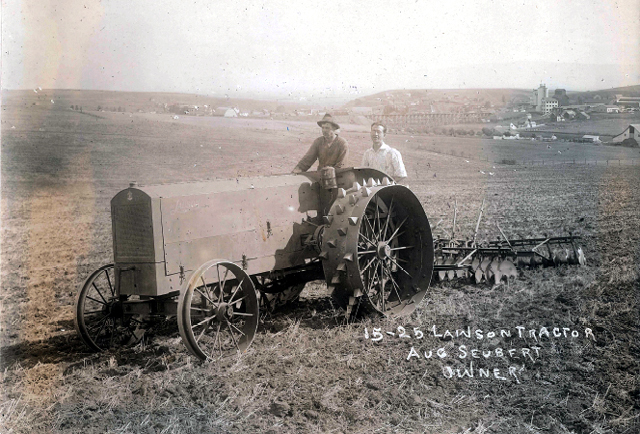
Gus Seubert and Frank Kelsey on a tractor tilling a field outside of Cottonwood. You can see the railroad trestle and Cottonwood in the background. Photo courtesy of Claudia Gehring. |
|